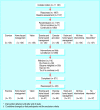Randomised factorial trial of falls prevention among older people living in their own homes
- PMID: 12130606
- PMCID: PMC117228
- DOI: 10.1136/bmj.325.7356.128
Randomised factorial trial of falls prevention among older people living in their own homes
Abstract
Objective: To test the effectiveness of, and explore interactions between, three interventions to prevent falls among older people.
Design: A randomised controlled trial with a full factorial design.
Setting: Urban community in Melbourne, Australia.
Participants: 1090 aged 70 years and over and living at home. Most were Australian born and rated their health as good to excellent; just over half lived alone.
Interventions: Three interventions (group based exercise, home hazard management, and vision improvement) delivered to eight groups defined by the presence or absence of each intervention.
Main outcome measure: Time to first fall ascertained by an 18 month falls calendar and analysed with survival analysis techniques. Changes to targeted risk factors were assessed by using measures of quadriceps strength, balance, vision, and number of hazards in the home.
Results: The rate ratio for exercise was 0.82 (95% confidence interval 0.70 to 0.97, P=0.02), and a significant effect (P<0.05) was observed for the combinations of interventions that involved exercise. Balance measures improved significantly among the exercise group. Neither home hazard management nor treatment of poor vision showed a significant effect. The strongest effect was observed for all three interventions combined (rate ratio 0.67 (0.51 to 0.88, P=0.004)), producing an estimated 14.0% reduction in the annual fall rate. The number of people needed to be treated to prevent one fall a year ranged from 32 for home hazard management to 7 for all three interventions combined.
Conclusions: Group based exercise was the most potent single intervention tested, and the reduction in falls among this group seems to have been associated with improved balance. Falls were further reduced by the addition of home hazard management or reduced vision management, or both of these. Cost effectiveness is yet to be examined. These findings are most applicable to Australian born adults aged 70-84 years living at home who rate their health as good.
Figures
Comment in
-
Tailored exercise is key to preventing falls.BMJ. 2002 Nov 16;325(7373):1177. doi: 10.1136/bmj.325.7373.1177/a. BMJ. 2002. PMID: 12433779 Free PMC article. No abstract available.
References
-
- Campbell AJ, Robertson CM, Gardner MM, Norton RN, Buchner DM. Psychotropic medication withdrawal and a home based exercise programme to prevent falls: a randomised controlled trial. J Am Geriatr Soc. 1999;47:850–853. - PubMed
-
- Cummings RG, Thomas M, Szonyi G, Salkeld G, O'Neill E, Westbury C, et al. Home visits by an occupational therapist for assessment and modification of environmental hazards: a randomised trial of falls prevention. J Am Geriatr Soc. 1999;47:1397–1402. - PubMed
-
- Smith J, Laidlaw C, Matthews J. RANDOM. Computer program. Melbourne: Statistical Centre, Peter MacCallum Cancer Institute; 1996.
-
- Pfieffer E. A short portable mental status questionnaire for the assessment of organic brain deficit in elderly patients. J Am Geriatr Soc. 1975;23:433–441. - PubMed
Publication types
MeSH terms
LinkOut - more resources
Full Text Sources
Medical


